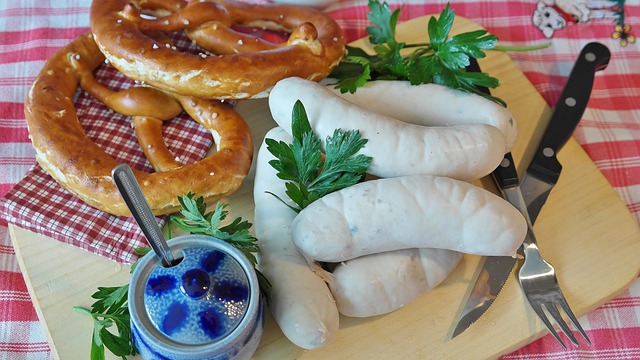
Germany, with its rich and diverse food traditions, has long been celebrated for its culinary prowess. Its regional specialities vary widely, reflecting the cultural influences, agricultural resources, and historical events that have shaped the nation. From hearty meat dishes and robust sausages to tangy sourdough bread and decadent cakes, German traditional food offers an incredible gastronomic journey.
- Sausages – The Staple Food of Germany
Germany is synonymous with sausages, known locally as “Wurst”. With over 1,500 types of sausages produced in the country, there’s an exceptional range of flavors and styles. The renowned Bratwurst, a seasoned pork, beef, or veal sausage, is a favorite at barbecues and festivals. The Currywurst, a steamed then fried pork sausage seasoned with curry ketchup, is a popular fast food in Berlin.
- Bread – The Backbone of German Cuisine
Germany is known for its bread, with more than 1,000 types available. From the rustic Rye bread (Roggenbrot) to the classic pretzels (Brezel) with their distinctive twisted shape, German bread is enjoyed at all meals. Bread is such an integral part of German food culture that it often substitutes for utensils, with thick slices used to scoop up hearty stews and dunk into dips.
- Regional Specialities – A Culinary Map
Each region in Germany has its unique culinary tradition. In Bavaria, the Weißwurst (white sausage) is a traditional morning meal. Served in a bowl of hot water with a side of sweet mustard and freshly baked pretzels, this delicacy is made from minced veal and back bacon.
The North Rhine-Westphalia region is famous for its Sauerbraten, a pot roast, usually of beef, marinated before slow cooking in a sweet-sour mixture. Served with red cabbage and potato dumplings (Kartoffelklöße), it is a comforting and filling meal.
From the Hesse region comes the Green Sauce or “Grüne Soße”, a cold herb sauce consisting of seven herbs, sour cream, and hard-boiled eggs. It’s typically served with boiled potatoes and either roasted beef or fish.
- Seafood – North Meets Baltic
Germany’s coastal regions offer an array of seafood. In the North and Baltic Sea regions, pickled herring, known as Bismarck Herring, is a local favourite. This tangy, sweet-sour fish is often served in a bread roll as a snack. Also popular is Fischbrötchen, a seafood sandwich typically with pickled herring, remoulade, pickles, and onions.
- Sweets and Desserts – The Finishing Touch
German pastries and desserts are as diverse and delightful as the main courses. The world-famous Black Forest Gateau, or Schwarzwälder Kirschtorte, is a heavenly mix of chocolate sponge cake, cherries, and whipped cream. Stollen, a fruit bread of nuts, spices, and dried or candied fruit, is traditionally enjoyed at Christmas.
The Berliner Pfannkuchen, a traditional German pastry similar to a doughnut with no central hole, filled with jam or plum sauce and dusted with powdered sugar, is a beloved treat, especially on New Year’s Eve and Carnival.
- Beverages – Beer and Beyond
Germany is globally celebrated for its beer, with more than 1,300 breweries in the country. From the crisp and clean Pilsners to the rich and smoky Rauchbier, German beers have set the standard in brewing.
However, beer is not the only beloved beverage. In wine regions like Rhineland-Palatinate and Baden-Württemberg, wines, especially Riesling and Spätburgunder (Pinot Noir), are widely consumed. Non-alcoholic drinks like Apfelschorle, a refreshing apple juice spritzer, and a variety of herbal and fruit teas also have their place in German cuisine.
Traditional German food is as diverse as the regions of the country, offering a range of hearty meats, bread, cheeses, sweets, and beverages. A journey through German cuisine is a gustatory exploration of the country’s rich history and cultural diversity. It reveals a culinary tradition that is hearty, diverse, and always inviting – a testament to the country’s love for good food and good times.
